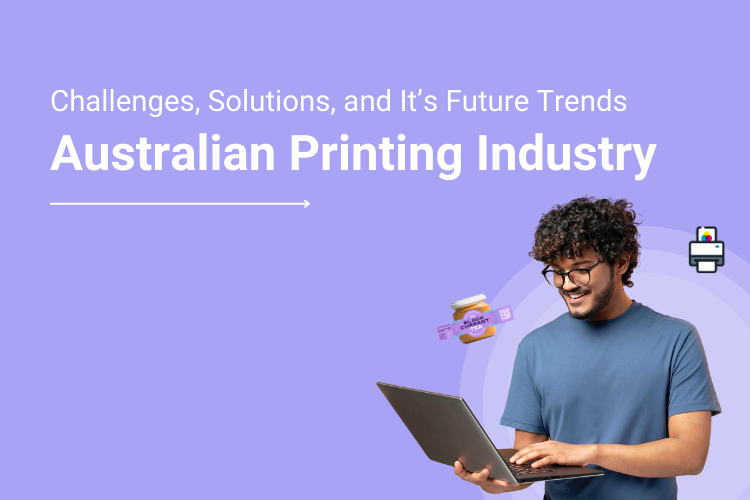The print industry is evolving globally, and for Australian printers, there’s a glimmer of hope.
One of the oldest industries, print, has undergone many revolutionary changes since its commencement. From woodblock printing to the current digital sweep, the print industry has experienced some of enormous shifts in the global market.
With the emergence of digital and Internet technologies in recent years, new printing trends have been discovered that are forever changing the printing industry. The latest digital inventions have changed the way companies are doing business, from the design to the printing phase of operations.
The transformational wave of the print industry is notable, although, it has never been a smooth ride. There has been a lot of ups and downs for the print industry in terms of technology, quality, demand, economy, geography, etc., but no matter how much we move into digitalization, nothing can replace the charm of printed products.
If we look into the bigger picture, the global figures of the print industry remain positive overall, and if we zoom especially into Australia, the implementation of new printing trends has updated the workflow and production strategies of Australian printers remarkably well to meet the changing demands and to spice up the entire print industry.
But, as the Australian market is continuously in flux and upgrading to the latest technologies and processes, there are specific challenges that the print industry is facing today, which we are going to look into to find a way out of it.
Challenges Faced by the Australian Printing Industry
The Australian printing industry is currently facing several challenges that are impacting its overall growth and sustainability. These 8 challenges are rooted in various factors, ranging from technological advancements to changing consumer preferences. Here 8 key challenges faced by the Australian printing industry:
1. Digital Transformation
The rise of digital media has revolutionized communication, altering how information is consumed and challenging print’s traditional dominance. Printers must embrace digital technologies to stay relevant.
2. Environmental Concerns
Amid growing environmental consciousness, the printing industry must implement eco-friendly practices. Reducing paper waste and adopting greener processes are essential for a sustainable future.
3. Cost Pressures
In an arena of fierce competition, printers grapple with the delicate balance of providing quality while navigating price pressures. Innovative, cost-effective strategies are essential for sustaining profitability.
4. Changing Consumer Behavior
As digital media becomes omnipresent, printers must understand and respond to evolving consumer preferences. Shifting the narrative around print and exploring novel avenues will help reignite demand.
In addition, learn more about The Impact of Innovative Packaging Printing and Trends in Australia in 2024
5. New Technology Adaption
Even though times have changed and competition has become fierce, there is a population of printers that practice traditional printing in spite of knowing that expansion is happening in their industry. Australian printers must be made to understand that by adopting new technologies like IoT, AI, the printing industry would experience more advanced devices resulting in a smoother overall workflow, which has become a considerable challenge.
Where printing trends are gearing towards full workflow automation with the development of computer-to-plate imaging technologies that allow desktop publishing applications to output directly to a printing plate, “hybrid” printing i.e., a combination of different reproduction processes since many print jobs are complicated with specialized coating or printing requirements, can be achieved which Australian printers must be introduced to. They must be explained about the growing trend in cross-media conversion from one file to any information distribution and electronic publishing methods along with the advancement of digital technologies such as Direct Imaging offset presses and Inkjet printers, which have made color printing cost-effective.
Related blog: Banner Printing Industry Trends
6. Changing Demands
Customer preferences are always changing. To keep up with it, one has to transform accordingly. In the present times, ‘services’ have taken precedence over providing products and subscriptions. Today, customers are more interested in doing business with companies that enable variability, catering to a level of quality and quantity based on what they require. In short, customization is ruling the print industry. Customers are looking for products that can be modified as they like which custom web-to-print software solution has made possible. Australian printing businesses can leverage the benefits of it by implementing web-to-print software to their online site and offering personalization to the customers and keeping them happy.
7. Digitalization
Printing is not limited to just paper or fabrics today. From shoes, bags, mobile covers, mugs, labels, trophies, and what not? One can get any product printed easily that, too, with customization. With digitalization, the print industry has been transformed remarkably well. With the help of various software like t-shirt design tool, business card design tool, greeting card makers, online photo album design, banner design, shoe design, web-to-print for personalized interior, etc. store owners can offer customers complete freedom to create, edit or upload designs, print them and even share their ideas to social media.

Where such automated workflow can eliminate the difficulties of printing processes and make it more customer interactive, the fear of digitalization replacing the old printing methods is yet another reason why the Australian print industry is lacking behind.
8. Adoption of Cloud MPS
The cloud technology and its benefits are known to us all, but in the print industry, approval of cloud-delivered MPS can do much more. A few of the market leaders, including Lexmark, Xerox, and Ricoh, are some of the companies that have already adopted this technology. Adoption of cloud-delivered MPS will reduce the complications of on-premise printing management and will eliminate the need for on-premises servers as well.
Future Trends Shaping the Australian Printing Landscap
As the digital age ushers in transformative shifts, the Australian printing industry stands at the crossroads of innovation, poised to redefine its essence and impact. Let’s explore the dynamic trends reshaping the industry and propelling it into an era of boundless possibilities.
Personalized Printing:
In an era of information overload, personalized printing emerges as a beacon of relevance. Harnessing data-driven insights, printers can create bespoke materials that resonate on a deeper level with recipients, forging stronger connections and enhancing the impact of print campaigns.
Web-to-Print Technology and Online Platforms:
A seamless creative journey, web-to-print technology revolutionizes the printing landscape by ushering in a realm of convenience. Empowering customers to become co-creators, these platforms allow for personalized design, easy order placement, and real-time collaboration, blurring the lines between printer and customer.
Sustainable Practices and Eco-Friendly Printing:
Printing with a conscience as environmental consciousness intensifies, sustainable printing practices take center stage. Embracing eco-friendly materials, energy-efficient processes, and reduced waste, the industry crafts a legacy of responsible production, echoing a commitment to a greener world.
Here’s everything you need to know about The Present Trend and The Future Scope of Sustainable Packaging
Integration of Augmented Reality and Printed Electronics:
Augmented reality seamlessly melds the digital and physical realms, amplifying the impact of print. By infusing printed materials with interactive elements, the industry transforms static content into dynamic experiences, captivating audiences and expanding the possibilities of print’s influence.
Exploration of 3D Printing Potential:
The allure of three-dimensional printing beckons, offering a canvas for innovation yet to be fully realized. Exploring this frontier holds the promise of creating tactile, immersive, and functional print products, unlocking a realm of groundbreaking applications across industries.
Conclusion
There’s much more to come in the coming years in the print industry, looking at the way it is unfolding day by day. The only way to overcome the fluctuations in the print market is by adopting the new technologies and trends and continuing to innovate their processes. New advances like multi-channel marketing, social media, and web to print software; and services and processes such as QR codes, 3D printing, and functional printing have made it possible to retain marketplace visibility and make an impact which Australian printers must take note of and start practicing in order to rise in their printing statistics.
FAQs
What are some potential solutions for the Australian printing industry to remain competitive?
Embracing technological innovations, investing in digital printing, developing sustainable practices, diversifying service offerings, collaborating with online platforms, and highlighting the unique value of print can help the industry stay competitive.
How is the shift towards digital media impacting the printing industry in Australia?
The shift towards digital media has led to reduced demand for traditional printed materials like newspapers and magazines. Printing companies are challenged to adapt by investing in digital printing technologies and finding ways to integrate print and digital strategies.
How is the Australian printing industry changing?
The Australian printing industry is undergoing a transformation driven by digitalization, sustainability, and diversification. Companies are adopting digital printing technologies for faster, customizable, and on-demand production while diversifying services beyond traditional print.
What steps can the Australian printing industry take to address the skills and workforce challenges?
The industry can invest in training and upskilling programs to develop a skilled workforce proficient in both traditional and digital printing technologies. Collaborating with educational institutions and industry associations can help bridge the skills gap.




